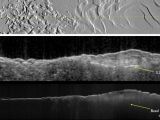Typical cameras on-board orbiters sent in solar system exploration missions can only map the surface of a planet or a moon. Scientists seldom get the opportunity to look under the surface of a cosmic body without actually landing a robotic mission on the respective planet, and even so it would only be effective in studying the first few decimeters of the surface.
Nevertheless, ESA's Mars Advanced Radar for Subsurface and Ionosphere Sounding instrument on-board the Mars Express probe has been successful in penetrating the Martian surface, in order to create a three-dimensional image of its structure. The new technique will probably be used in future missions to study other places in the solar system.
This is the first time when a probe in orbit around a planet makes use of a radar sounder to study the subsurface of a planet. In fact, researchers didn't even know if the technique would work as predicted, because there was as considerable chance that the subsurface or the ionosphere of Mars would be opaque to radar waves.
"We have demonstrated that the polar caps at Mars are mostly water ice, and produced an inventory so now we know exactly how much water there is," said MARSIS Deputy Principal Investigator, Roberto Orosei. One of the most immediate targets for the radar sounding technique in other missions in the solar system would be Jupiter's Europa, which is thought to house a ocean of water and probably even life under its thick water ice crust.
On Saturn's Titan for example, the radar sounding technique could be used to determine the depth of the natural gas lakes observed on its surface, while Enceladus would be probed in order to determine the structure of geysers hidden beneath the surface. "Radar sounders are very well suited to exploring icy worlds," said Orosei.
Alternatively, astrophysicists reckon that asteroids and comets may also be scanned with radar sounder, to create three-dimensional maps of their interior.

 14 DAY TRIAL //
14 DAY TRIAL // 
